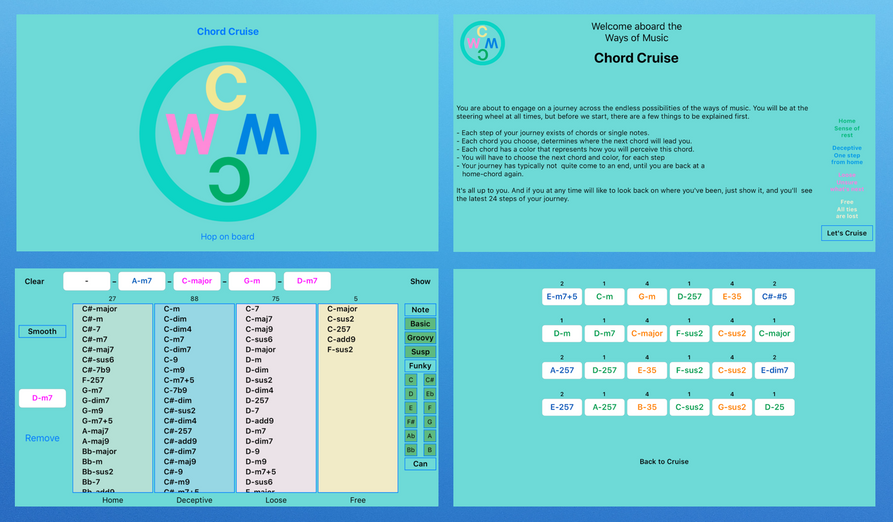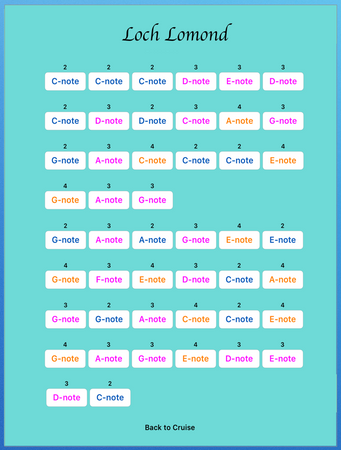
Ways of Music
The Chord Cruiser App
Available on Google Play
Available on Apple App Store
Please notice that the Android and IOS version has slightly different functionality, but in essence based on the same core functionality.

Colors matter
And what I mean by that is, that - ALL colors matter.
No one is more important that the other. No single one can be whole on it’s own, and is but a pale noise when not accompanied by all the others. No one contributes nor gets respect, without inviting the other ones in.
A community of colors is greater than the sum of it’s parts, and only together can they make a symphony and enforce harmony.
There is no journey and no interesting story to be told without colors. We need to mix. With mixing comes purpose and excitement, curiosity and relief, depth and enlightenment. Without mixing there will be no joy, no satisfaction, no beginning worth mentioning and no satisfactory end.
So let go of the narrow-minded attitude. Dare, reach out, invite all the colors in, stay curious, explore, listen, praise and enjoy. They are the keys to life, and will resonate with something that has always been there inside you, in your heart and soul. Only by opening your heart and inviting all colors in, you will truly feel at home.
Imagine that ….
If you feel this way too, please spread the word.
What’s up with the Pentatonics
A scale of only 5 notes, with a potential that demands this scale to be in the toolbox of all musicians, regardless of what instrument they play.
Famous guitar-licks, bass-lines, violin solo’s, piano runs and even many honorable complete melodies have been written using only these 5 notes.
If you don’t already know the Pentatonic scale, think of it like all the black keys on the piano. There are 11 other ways to create the scale on the piano, and It can of cause also be made of only white keys - the C-pentatonic scale - but regardless, it has to follow this exact pattern; 1-1-3/2-1-3/2.
Then, what makes these 5 notes so special in combination ?
The short answer is: these 5 notes can be used in arbitrary sequence, endlessly, and will continue to sound fluently without you ever having the feeling of them coming to rest.
The even shorter answer: there are no ½-steps.
Single note melodies can only come definitely to rest in a sequence where at least two of the involved notes are a ½ step apart. So if you are playing a pentatonic melody on your violin, bass, flute, cello - you get the picture - then you should be alright. But if chords are being used, everything is possible, so you need to be little more carefull when you play, for example on the guitar or the piano.
Auld lang syne, Swing low sweet chariot, Amazing grace, My girl, Don’t look back in anger - are all very famous melodies based solely on the pentatonic scale.
And if you allow one or two ½ step slides during the melody, many many more famous melodies line up - including Let it be, Summertime and Loch Lomond
Let’s look at an example. Let’s try to visualize what it is that our ears are hearing, while listening to Lock Lomond.
The Ways of Music app uses the concept of music-tuning, to visualize the actual perceived tuning of each note. Tuning can be from 1 - 4, and in the illustration shown here, colors are being used to represent these tuning-levels, to make it easier to grasp. Notice that Green = definitively home and at rest, is not to be seen anywhere. The nextbest is blue = deceptively at home. And notice that the melody ends at a blue C.
Now please notice also this:
Throughout the melody, the note C has different tuning levels - blue, magenta, yellow - depending on the context. And the same goes with all the other 4 notes in the pentatonic scale. Never green, always ready to move on with additional tones if needed, but also with the potential to deceptively fall to rest.
This scale is the perfect playground for melodies, arpeggios, fillers and improvisation licks, or whatever you would like to use the for.
Try to play the melody while listening and viewing the coloring of the notes at the same time. This is the perfect way to start getting to now the Pentatonic scale and understand it’s greatness. And from there, you are ready to start improvising your own melodies.
Thank you for the music, bonnie bonnie Loch Lomond.

